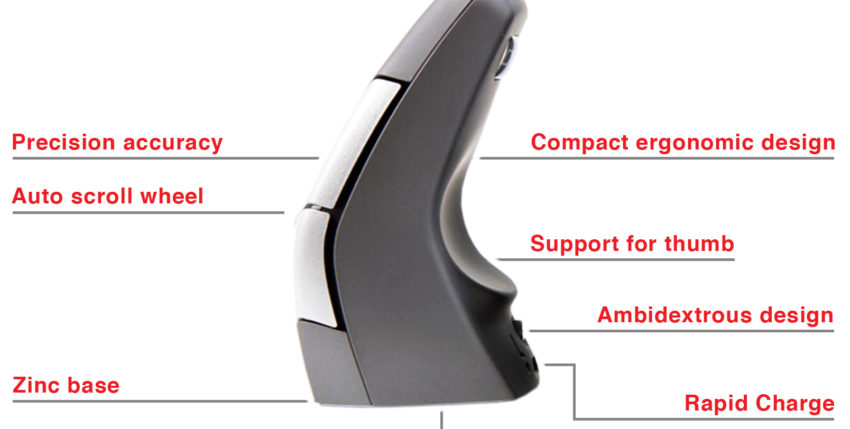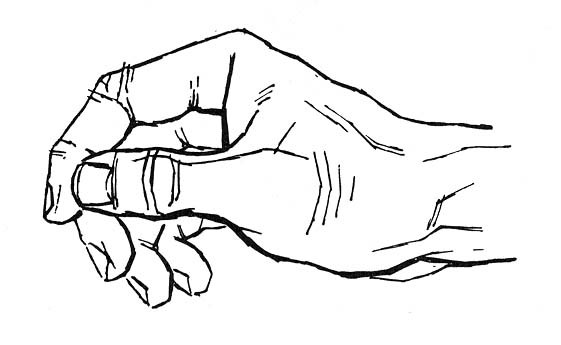
The best ergonomic mouse to manage repetitive strain injury (RSI)
By Stephen Bowden, Chartered Ergonomist
Repetitive strain injury is described by the NHS a ‘general term used to describe the pain felt in muscles, nerves and tendons caused by repetitive movement and overuse’.
Sometimes referred to as ‘Upper Limb Disorders’ common areas of discomfort are normally found within the forearms and elbows, writs/hands and neck/shoulders.
Prior to the computer, the majority of repetitive strain injuries were found within the manufacturing industry. With computers including smartphones and tablets now dominating the modern world, RSIs are a common issue that can affect wellbeing and productivity.
Potential symptoms of RSI
Possible symptoms may include:
- Sharp pains
- Numbness
- Aching
- Tingling
- Weakness
Potential causes of RSI
RSI has a number of possible causes. These may include:
- Using vibrating equipment.
- Carrying out repetitive tasks while adopting an awkward posture.
- Adopting fixed static postures for extended periods.
- Everyday static postures placing the neural system on full stretch.
- Repetition of movement while in a static posture.
Examples of everyday static postures that can increase risk of RSI include but are not limited to:
- Sitting in bed to read a book with your legs stretched out flat and your beck bent forward.
- Side lying in bed with your elbow bent up and the side of your head supported by the palm of the hand
- Operates a keyboard and mouse with a posture of the spine in some degree of flexion or “slumped” with a poking out chin.
The Neural System and Neurogenic inflammation in relation to RSI
The Neural System and neurogenic inflammation may be an overlooked cause of pain related to chronic repetitive strain injury (RSI). (3)
We all know that our muscles contract and cause the joints to move as when raising a telephone phone to you ear. Did you know, however, that your nerve tissue also needs to move freely and unimpeded throughout this movement? (2)
Electrical impulses originating in the Motor Cortex of the brain pass to the spine and then pass along the nerves mentioned above to initiate and control the myriad of movements we carry out each day.
Each nerve lays in a conduit or pathway to reach the muscles where the electrical impulses cause the muscles to contract and produce the movement such as picking up a telephone.
The structure of these pathways is somewhat analogous to underground telephone cables running in tubes or conduits.
Unlike the underground telephone cables that only move along their conduits during construction or replacement the nerves lying in their conduits within the human body must be able to constantly slide and move. If a nerve movement is impeded at any point in the conduits between your spine and your fingers, then the nerve will be stretched beyond its natural elastic limit causing adverse neural tension.
Median nerve impediment when using a computer mouse
If the median nerve is impeded at the elbow as is passes under a muscle when using a computer mouse then the nerve will not be able to slide at two points in its path between the elbow and the neck. Furthermore, repetitive movement in the limb will aggravate the median nerve still further by repeated stretching causing a neuropathy and further nerve damage.
Numbness and or partial numbness are an immediate indication of neural damage and these symptoms can occur without pain. Weakness can occur and along with numbness other symptoms such as a sense of swelling can occur and various descriptions of the perceptions of pain including, “vague”, “deep”, “burning” “heaviness”, “searing” and many other terms. The symptoms can be worse at night and at the end of the day. 1.
How can an Ergonomic Mouse help Prevent RSI?
In order to prevent the symptoms that are caused by RSI & adverse neural tension, the best strategy is to avoid static postures non neutral postures that place the neural system on tension. A common posture adopted by millions of people is the pronated (or hand flat on desk posture, image 1) adopted when using a standard computer mouse. Joints of the human body do not like to adopt end of range posture for extended periods of time. Fully pronating your forearm for extended periods may increase the risk of RSI when using a computer mouse.

Image 1: Pronated forearm when using mouse
Adopt a neutral hand posture to reduce the risk of RSI
An important matter to note is that placing the hand in a vertical position to hold a mouse is not placing the hand in a neutral posture as is commonly supposed. Image 2 below shows elbow and wrist at 0 (or vertical) degrees of pronation and supination. This vertical position provides doctors a standard means of measuring the amount of movement in a joint so that all doctors can understand the degree of restriction in a given joint when they are assessing a joint condition previously attended to by a another doctor.
This standard means of measuring movement is misunderstood by many as being the neutral position of the hand and wrist. The true neutral position of the hand (Position of Function or rest) is seen below within Image 3

Image 2. Vertical position of hand and wrist
 Image 3. Neutral position of hand- Position of function/rest
Image 3. Neutral position of hand- Position of function/rest
A mouse that affords a neutral position of the hand is one that can be held in the tips of the fingers with a gap between the back of the mouse and the palm of the hand allowing the forearm to rotate somewhat towards the work surface. This form of holding the mouse is called the Position of function/rest as seen within image 4.

Image 4 – Position of function/rest while using the DXT Mouse
Summary
In order to prevent the symptoms of RSI caused by neural tension it is important to regularly move between neutral postures and use an appropriate ergonomic mouse that utilises the Position of Function/Rest.
You should also consider practicing using the mouse in your non dominant mouse hand to reduce the load on the hand with symptoms of RSI. The DXT Ergonomic Mouse allows you at the switch of a button to change from right to left hand.
You can watch a video of the DXT Ergonomic mouse below:
References
1. Butler D S; 1991 Mobilisation of the Nervous System Churchill Livingstone
2. Miller J; 2019 Carpal Tunnel Syndrome. On Line Article https://physioworks.com.au/treatments-1/neurodynamics-neuro-mobilisation
3. Panagos A; 2019 Treatment of an Upper Extremity Chronic Repetitive Strain Injury of 28 Years Duration in a Professional Jazz Saxophonist Using 5% Dextrose Cureus. Feb; 11(2): e4116.
